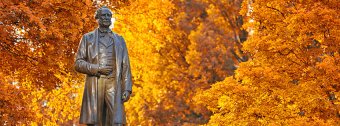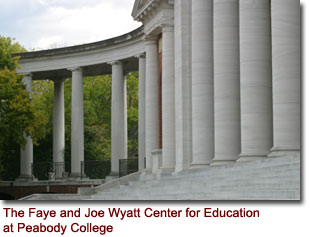

Commodore Cornelius Vanderbilt was in his 79th year when he decided to make the gift that founded Vanderbilt University in the spring of 1873.
The $1 million that he gave to endow and build the university was the commodore's only major philanthropy. Methodist Bishop Holland N. McTyeire of Nashville, husband of Amelia Townsend who was a cousin of the commodore's young second wife Frank Crawford, went to New York for medical treatment early in 1873 and spent time recovering in the Vanderbilt mansion. He won the commodore's admiration and support for the project of building a university in the South that would "contribute to strengthening the ties which should exist between all sections of our common country."
 McTyeire chose the site for the campus, supervised the construction of buildings and personally planted many of the trees that today make Vanderbilt a national arboretum. At the outset, the university consisted of one Main Building (now Kirkland Hall), an astronomical observatory and houses for professors. Landon C. Garland was Vanderbilt's first chancellor, serving from 1875 to 1893. He advised McTyeire in selecting the faculty, arranged the curriculum and set the policies of the university.
McTyeire chose the site for the campus, supervised the construction of buildings and personally planted many of the trees that today make Vanderbilt a national arboretum. At the outset, the university consisted of one Main Building (now Kirkland Hall), an astronomical observatory and houses for professors. Landon C. Garland was Vanderbilt's first chancellor, serving from 1875 to 1893. He advised McTyeire in selecting the faculty, arranged the curriculum and set the policies of the university.
For the first 40 years of its existence, Vanderbilt was under the auspices of the Methodist Episcopal Church, South. The Vanderbilt Board of Trust severed its ties with the church in June 1914 as a result of a dispute with the bishops over who would appoint university trustees.
 From the outset, Vanderbilt met two definitions of a university: It offered work in the liberal arts and sciences beyond the baccalaureate degree and it embraced several professional schools in addition to its college. James H. Kirkland, the longest serving chancellor in university history (1893-1937), followed Chancellor Garland. He guided Vanderbilt to rebuild after a fire in 1905 that consumed the main building, which was renamed in Kirkland's honor, and all its contents. He also navigated the university through the separation from the Methodist Church. Notable advances in graduate studies were made under the third chancellor, Oliver Cromwell Carmichael (1937-46). He also created the Joint University Library, brought about by a coalition of Vanderbilt, Peabody College and Scarritt College.
From the outset, Vanderbilt met two definitions of a university: It offered work in the liberal arts and sciences beyond the baccalaureate degree and it embraced several professional schools in addition to its college. James H. Kirkland, the longest serving chancellor in university history (1893-1937), followed Chancellor Garland. He guided Vanderbilt to rebuild after a fire in 1905 that consumed the main building, which was renamed in Kirkland's honor, and all its contents. He also navigated the university through the separation from the Methodist Church. Notable advances in graduate studies were made under the third chancellor, Oliver Cromwell Carmichael (1937-46). He also created the Joint University Library, brought about by a coalition of Vanderbilt, Peabody College and Scarritt College.
Remarkable continuity has characterized the government of Vanderbilt. The original charter, issued in 1872, was amended in 1873 to make the legal name of the corporation "The Vanderbilt University." The charter has not been altered since.
RELATED VIDEO



 The University of Pittsburgh Medical Center (UPMC) is an $9 billion integrated global nonprofit health enterprise that has 54,000 employees, 20 hospitals, 4,200 licensed beds, 400 outpatient sites and doctors’ offices, a 1.5 million-member health insurance division...
The University of Pittsburgh Medical Center (UPMC) is an $9 billion integrated global nonprofit health enterprise that has 54,000 employees, 20 hospitals, 4,200 licensed beds, 400 outpatient sites and doctors’ offices, a 1.5 million-member health insurance division...
 The Michigan State University College of Human Medicine (MSUCHM) is an academic division of Michigan State University (MSU), and grants the Doctor of Medicine (MD) degree. CHM was founded in 1964 as the first community-integrated medical school, and has a program...
The Michigan State University College of Human Medicine (MSUCHM) is an academic division of Michigan State University (MSU), and grants the Doctor of Medicine (MD) degree. CHM was founded in 1964 as the first community-integrated medical school, and has a program...








